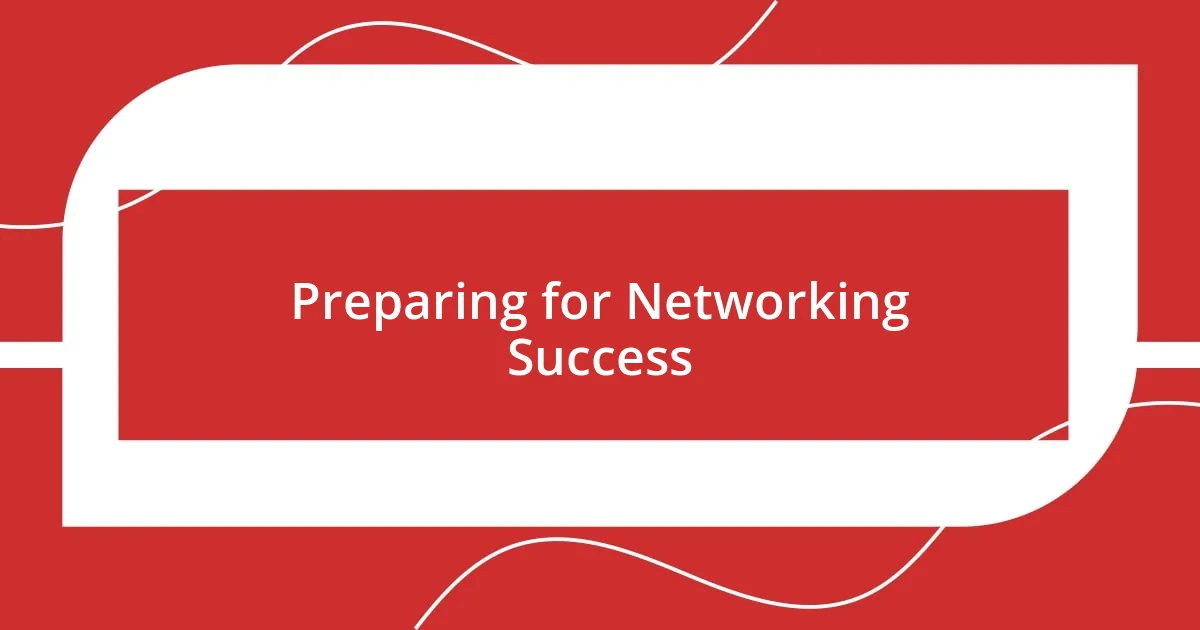Key takeaways:
- Networking events are opportunities for genuine connections, not just business card exchanges; listening intently can transform casual interactions into meaningful relationships.
- Preparation is essential: having conversation starters, researching attendees, and dressing appropriately enhances confidence and engagement.
- Follow-up after events is crucial; personalized messages referencing shared interests can solidify connections and spark deeper dialogues.
- Utilizing social media effectively broadens networking opportunities and fosters connections beyond physical events, making interactions more dynamic and accessible.

Understanding Networking Events
Networking events offer a unique opportunity to connect with individuals who share similar professional interests. I remember attending a local conference where I struck up a conversation with a stranger, and it turned out that we had overlapping goals and could collaborate on future projects. Isn’t it fascinating how a simple chat can open doors to unexpected partnerships?
The atmosphere at these events can be both exhilarating and intimidating. I’ve felt that knot in my stomach when entering a room filled with people I don’t know. But I’ve learned that embracing that nervousness can lead to genuine connections. Have you ever found that stepping out of your comfort zone often yields the most rewarding experiences?
Understanding the dynamics at play during networking events is crucial. They’re not just about exchanging business cards; they’re a space to create relationships. In my experience, those moments when I focused on listening intently to others made the biggest difference, transforming casual introductions into meaningful interactions. How do you approach conversations when meeting new people in these settings?

Preparing for Networking Success
Preparing for a networking event starts well before you walk through the door. I often find that having a plan helps ease the anxiety of mingling with strangers. For instance, I jot down a few conversation starters or questions I could ask potential contacts. Reflecting on a past event, I prepared a list highlighting my goals and the individuals I wanted to meet. This gave me a roadmap to navigate the crowd and ensured I made the most of my time.
Another effective strategy in my experience is researching attendees or speakers ahead of the event. I recall attending a tech conference where I looked up a few key people on LinkedIn. This not only provided me with context for our conversations but also made me feel more confident approaching them. Knowing a bit about someone’s work or interests helps create a more authentic connection rather than just a generic small-talk exchange.
Lastly, I always make sure to dress appropriately for the event. The right attire can really impact your confidence. I’ve attended events where I felt out of place because I didn’t align my outfit with the networking culture of the industry. I realized that taking a moment to assess the dress code can contribute significantly to how I present myself and relate to others.
| Preparation Aspect | Personal Insights |
|---|---|
| Planning | Writing down goals and starters boosts my confidence. |
| Research | Learning about attendees creates authentic connections. |
| Attire | Dressing appropriately enhances my self-presentation. |

Building Genuine Connections
Building genuine connections at networking events is about moving beyond the surface level. I’ve often found that people appreciate sincerity over small talk. For instance, during a lively industry gathering, I approached someone with genuine curiosity about their work instead of simply asking, “What do you do?” This shift in approach led to a conversation that revealed shared values and interests, creating a bond that extended beyond that evening.
To foster authentic connections, consider these strategies:
- Be present: Focus on the conversation instead of scanning the room for your next target.
- Ask open-ended questions: Encourage others to share their experiences and insights, creating more engaging discussions.
- Share personal stories: Relating on a human level creates empathy and understanding.
- Follow up: A simple message after the event can transform an initial encounter into a lasting connection.
Embracing vulnerability can also lead to deeper connections; I’ve found that when I share my own challenges, it resonates with others and fosters authentic dialogues. It’s intriguing how sharing our imperfections can break down barriers and build trust. How do you create moments of vulnerability in your conversations?

Engaging in Meaningful Conversations
Engaging in meaningful conversations requires a genuine curiosity about others. I remember a time at a networking event when I asked someone about their biggest passion project instead of the usual questions. The look on their face was priceless; it was like a light bulb went off, and for the next half hour, we dove deep into their journey and aspirations. This not only made our conversation more memorable but also left me inspired.
It’s essential to listen actively. When people see that you genuinely care, they open up in ways that superficial chit-chat simply cannot achieve. I once practiced this approach with a fellow attendee who felt nervous about sharing their ideas. By nodding and responding thoughtfully, I noticed their confidence grow, leading us to explore some fascinating concepts together. Isn’t it amazing how a bit of attention can transform a simple exchange into a profound conversation?
Sometimes I find that humor can also pave the way for deeper connections. At an event, I shared a light-hearted anecdote about my own networking mishaps, which prompted others to laugh and share their own stories too. Those shared moments of laughter created a bond that made everyone more comfortable, allowing for more in-depth discussions afterward. Isn’t it interesting how vulnerability and humor can be such powerful tools in networking?

Following Up Effectively After Events
Following up after a networking event is crucial for solidifying the connections you’ve made, and I can’t stress enough how a simple message can go a long way. I remember an instance where I reached out to someone I met at a conference with a specific reference to our conversation about sustainable practices in the industry. They responded positively, and that initial follow-up eventually led to a collaborative project between us. Don’t you think it’s remarkable how something so small can snowball into exciting opportunities?
Timing is also an essential part of follow-ups. I’ve found that sending a message within a couple of days keeps the momentum going. When I recently followed up with a new contact, I made sure to express my appreciation for their insights and suggested a coffee chat to explore our shared interests further. Waiting too long can make your interaction feel stale, right? It’s all about keeping the excitement alive while the memory of the event is fresh.
Personalizing your follow-up can make a big difference. Instead of a generic “Nice to meet you,” I once tailored my message to reflect our shared passion for mentorship, even referencing a quote they mentioned during our conversation. This not only shown that I was genuinely invested but also sparked a deeper dialogue. Engaging like this makes your follow-up feel less transactional and more relational, wouldn’t you agree?

Leveraging Social Media for Networking
Social media is an incredible tool for networking, and I’ve found that utilizing platforms like LinkedIn can open up so many avenues. There was a time when I connected with someone I met briefly at an event through LinkedIn, and just adding a personalized note mentioning our interaction made all the difference. It was heartening to see how a simple gesture led to dynamic conversations about opportunities in our field. Have you ever felt that online platforms could bridge gaps created by geographical distance?
Another strategy I find effective is using Twitter to engage with industry leaders and peers. By sharing insightful articles, commenting on threads, or even retweeting their posts, I’ve built rapport without needing to be in the same physical space. I distinctly recall when I started a discussion about an event I attended; it resulted in a couple of unexpected DMs that turned into insightful exchanges and new connections. Isn’t it fascinating how a virtual interaction can transform into meaningful relationships?
Moreover, I believe Instagram can be a powerful tool for showcasing your personality. I remember sharing a behind-the-scenes moment from a recent networking event—the coffee station set up in the breakout area—along with a fun caption. Not only did it keep my followers informed, but it also prompted several comments from attendees who shared similar experiences, creating a shared sense of community. Have you considered how sharing those little glimpses of your professional life can make networking feel more approachable?

Reflecting on Networking Experiences
Reflecting on my networking experiences often brings to light just how vital it is to be present during conversations. I remember attending a local meet-up where I made a concerted effort to listen intently, rather than focusing solely on what I would say next. This small change in approach led to a deeper connection with a fellow attendee, who later shared invaluable insights about navigating our industry. Have you ever noticed how genuine engagement can spark unexpected relationships?
Another layer I find fascinating is the diverse perspectives I encounter at different events. One time, I joined a roundtable discussion where participants ranged from seasoned executives to fresh graduates, and it was enlightening to hear everyone’s unique experiences. This exchange shifted my perception of networking; I realized it’s not just about adding contacts but enriching my understanding of various viewpoints. Isn’t it interesting how stepping outside our comfort zones can lead to such growth?
Ultimately, I’ve learned that reflecting on these connections regularly enriches my networking practice. After each event, I jot down key takeaways and memorable interactions, which not only reinforces those connections but also provides a roadmap for future conversations. I still remember looking back on my notes after an industry expo and reaching out to someone I had promised to follow up with. It turned into a fruitful mentorship that I cherish. How do you keep track of your networking connections?















